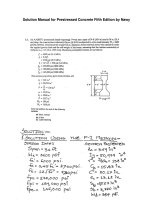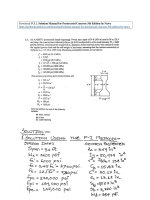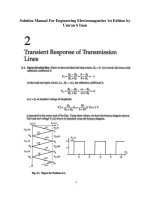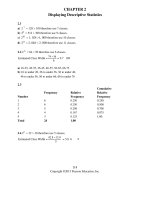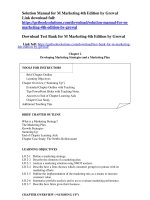Solution manual for international macroeconomics 2nd edition by feenstra
Bạn đang xem bản rút gọn của tài liệu. Xem và tải ngay bản đầy đủ của tài liệu tại đây (259.42 KB, 4 trang )
The Global Macroeconomy
1
1. The data in Table 1-1 end in 2009. Visit the U.S. Bureau of Economic Analysis at
bea.gov to find information for the latest full calendar year (or for the last four quarters). What is the latest estimate of the size of the annual U.S. current account deficit
in billions of dollars?
Answer: Answers will vary.
2. The data in Figure 1-1 end in 2010.Visit oanda.com and download data on the same
exchange rates (yuan per dollar and dollar per euro) for the past 12 months. What are
the rates today? What were they a year ago? By what percentage amount did the rates
change? At oanda.com, click on “Currency Tools” and then “FXGraph” and use the
tool to plot the last year of data for each exchange rate. Do you think the rates are
floating or fixed?
Answer: Answers will vary. The yuan per dollar exchange rate is fixed (with occasional changes in value) and the euro–dollar exchange rate is floating.
3. The data in Figure 1-3 are for the year 2005. Find the IMF’s World Economic Outlook Databases. (Hint: Google “World Economic Outlook Databases.”) Use this interactive tool to obtain the latest data on current accounts in U.S. dollars for all countries (actual data or IMF estimates). Which countries had the 10 largest deficits last
year? Which countries had the 10 largest surpluses last year?
Answer: Answers will vary. As of October 25, 2010, the 10 countries with the largest
current account deficits were:
Country
United States
Spain
Italy
France
Australia
Canada
Greece
India
Brazil
United Kingdom
2008
2009
2010
–668.856
–155.962
–78.874
–54.629
–47.477
–6.483
–51.212
–25.48
–28.192
–44.063
–378.434
–81.198
–67.151
–51.287
–43.693
–38.075
–37.092
–35.672
–24.302
–24.259
–466.513
–71.92
–58.272
–45.743
–29.828
–44.245
–33.053
–44.093
–51.822
–50.31
S-1
Full file at />
S-2 Solutions
■
Chapter 1
The Global macroeconomy
The 10 economies with the largest current account surpluses were:
Country
Singapore
Switzerland
Korea
Netherlands
Taiwan Province of China
Russia
Norway
Japan
Germany
China
2008
2009
2010
35.815
10.234
–5.776
41.978
27.505
103.722
79.885
157.079
245.722
436.107
32.387
41.697
42.668
42.702
42.916
49.518
49.58
141.751
163.256
297.1
44.481
50.004
26.041
44.024
42.639
69.828
68.572
166.463
200.188
269.87
4. Figure 1-6 presents data on country risk (emerging market interest rate spreads) for
2005.Visit the Financial Times Web site (at ; in the drop down list under “Markets” click on “Markets Data”) to download data for country risk today. (Hint:
Google “FT high yield emerging markets.”) Which three emerging-market countries
have the highest spreads on their U.S. dollar debt? Which three have the lowest?
Answer: Answers will vary.
5. The map at the end of the chapter shows the World Bank’s composite governance indicator. The World Bank has prepared other indicators to measure institutional differences among countries. Use the Internet to find the World Bank’s “Ease of Doing
Business Map.” (Hint: Again, use Google.) Do you notice a correlation between the
ease of doing business and the overall governance indicator? Can you find countries
that rank high on the ease of doing business indicator but low on the governance indicator? Are these countries rich or poor? (Hint: Look up their GNI per person at
the World Bank by googling “world bank GNI per capita.”)
Answer: There is a positive relationship between the governance quality indicators
and the ease of doing business. There are examples of countries that rank high on the
ease of business but low on governance, such as Thailand, Tonga, Mongolia, China,
Georgia, Armenia, Romania, Saudi Arabia, Peru, Belize, and Sri Lanka. Most of these
are developing, low-income countries. Saudi Arabia, ranked roughly 50th in the world
in terms of income per person, is a notable exception.
Full file at />
■
Solutions
Chapter 1 The Global macroeconomy
6. The following charts show the growth of real GDP per capita in three pairs of geographically adjacent countries: North and South Korea, Argentina and Chile, and
Zimbabwe and Botswana (using data from the Penn World Table).
Real GDP
per capita
$14,000
Real GDP
per capita
$20,000
18,000
Real GDP
per capita
$10,000
South Korea
12,000
16,000
14,000
10,000
12,000
8,000
9,000
Argentina
8,000
7,000
6,000
Chile
10,000
5,000
8,000
6,000
4,000
6,000
4,000
3,000
4,000
2,000
North Korea
0
1950 1960 1970 1980 1990 2000
Botswana
2,000
2,000
Zimbabwe
1,000
0
1950 1960 1970 1980 1990 2000
0
1950 1960 1970 1980 1990 2000
a. Which country in each pair experienced faster growth in GDP per capita?
Which one is now richest?
Answer: South Korea experienced faster growth than North Korea. Argentina
experienced faster growth than Chile between 1970 and 1990, but Chile’s
growth rate was higher than Argentina’s between 1990 and 2000. Botswana has
grown faster than Zimbabwe since 1970. As of 2006, the richest countries are:
South Korea, Chile, and Botswana.
b. The World Bank’s World Governance Indicators for each country in 2000 were
as follows (higher is better). Based on these data, do you think institutions can
explain the divergent outcomes in these countries? Explain. Why do you think
it helps to compare countries that are physically contiguous?
Control of
Corruption
South Korea
North Korea
Chile
Argentina
Botswana
Zimbabwe
0.37
Ϫ0.93
1.56
Ϫ0.34
1.02
Ϫ0.87
Government
Effectiveness
0.63
Ϫ1.10
1.34
0.28
0.98
Ϫ1.13
Political Stability
and Absence
of Violence
0.49
Ϫ0.66
0.85
0.48
0.90
Ϫ1.21
Rule
of Law
0.64
Ϫ1.08
1.31
0.17
0.67
Ϫ0.74
Regulatory
Quality
0.47
Ϫ1.70
1.38
0.45
0.79
Ϫ1.61
Voice and
Accountability
0.76
Ϫ2.02
0.56
0.44
0.78
Ϫ0.97
Answer: South Korea has consistently higher governance ratings than North
Korea. Similarly, Chile’s are higher than Argentina’s ratings, and Botswana’s are
higher than Zimbabwe’s. Based on the information for these six countries, it appears as though quality governance is associated with higher economic growth.
Full file at />
S-3
Full file at />
